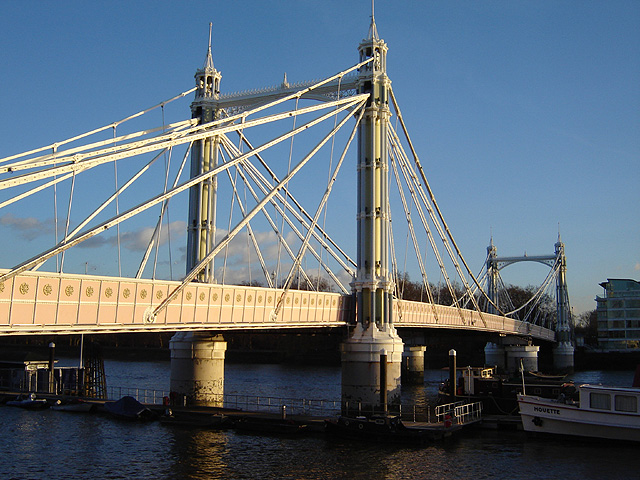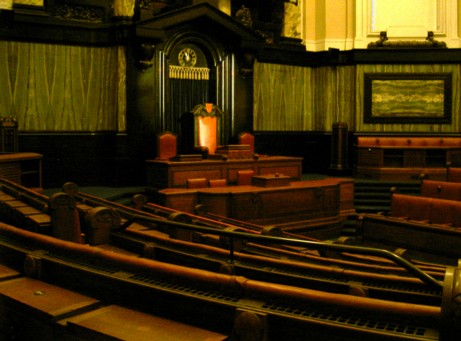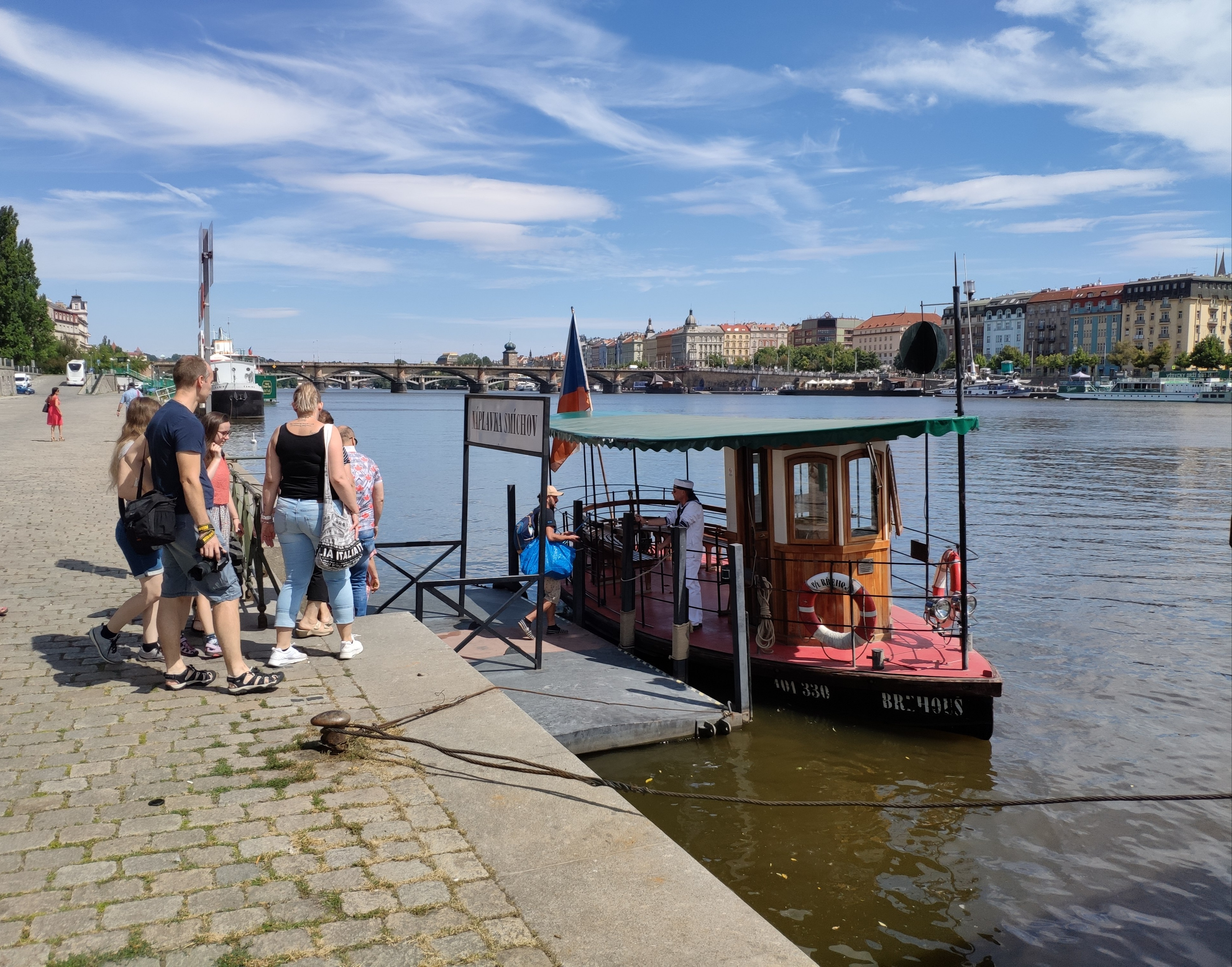|
Ordish–Lefeuvre System
The Ordish–Lefeuvre system or principle is an early form of cable-stayed bridge design, patented by English engineers Rowland Mason Ordish and William Henry Le Feuvre in 1858. The Ordish–Lefeuvre system differs from conventional suspension bridges in that, while as with a conventional suspension bridge a parabolic cable supports the centre of the bridge, inclined stays support the remainder of the bridge's load. Each stay consists of a flat wrought iron bar attached to the bridge deck, and a wire rope connects the wrought iron bar to one of four octagonal support columns. Only two major bridges were built using the Ordish–Lefeuvre principle. Ordish was commissioned to build Albert Bridge in Chelsea, London, using the design in 1864, but the start of work on the bridge was delayed due to negotiations regarding the proposed Chelsea Embankment at the northern end of the proposed bridge. While plans for the Chelsea Embankment were debated, Ordish built the Franz Joseph Bridg ... [...More Info...] [...Related Items...] OR: [Wikipedia] [Google] [Baidu] |
Bridge Of Franz Joseph I
A bridge is a structure built to span a physical obstacle (such as a body of water, valley, road, or railway) without blocking the path underneath. It is constructed for the purpose of providing passage over the obstacle, which is usually something that is otherwise difficult or impossible to cross. There are many different designs of bridges, each serving a particular purpose and applicable to different situations. Designs of bridges vary depending on factors such as the function of the bridge, the nature of the terrain where the bridge is constructed and anchored, the material used to make it, and the funds available to build it. The earliest bridges were likely made with fallen trees and stepping stones. The Neolithic people built boardwalk bridges across marshland. The Arkadiko Bridge, dating from the 13th century BC, in the Peloponnese is one of the oldest arch bridges in existence and use. Etymology The ''Oxford English Dictionary'' traces the origin of the word ''bridge' ... [...More Info...] [...Related Items...] OR: [Wikipedia] [Google] [Baidu] |
Franz Joseph Bridge
Franz Joseph Bridge (), later renamed Štefanik Bridge (), was a suspension bridge over the Vltava in Prague, opened in 1868. The bridge was designed by the English engineer Rowland Mason Ordish. The design, which used the Ordish–Lefeuvre system, was originally created for the Albert Bridge over the River Thames in London. However, after construction of the Albert Bridge was delayed, Ordish decided to build a bridge in Prague first. The foundation stone was laid on 19 October 1865, and engineer František Schön was charged with supervising the construction work. Emperor Franz Joseph, after whom the bridge was named, attended the ceremonies for its opening on 13 May 1868. Much like its London counterpart, the Franz Joseph Bridge featured a combination of stay and suspension rods. The latter formed a cable which held the diagonal stay rods. The main span was long and wide, while the entire structure was over long. The bridge was gradually strengthened and rebuilt in the 1890 ... [...More Info...] [...Related Items...] OR: [Wikipedia] [Google] [Baidu] |
Second World War
World War II or the Second World War (1 September 1939 – 2 September 1945) was a World war, global conflict between two coalitions: the Allies of World War II, Allies and the Axis powers. World War II by country, Nearly all of the world's countries participated, with many nations mobilising all resources in pursuit of total war. Tanks in World War II, Tanks and Air warfare of World War II, aircraft played major roles, enabling the strategic bombing of cities and delivery of the Atomic bombings of Hiroshima and Nagasaki, first and only nuclear weapons ever used in war. World War II is the List of wars by death toll, deadliest conflict in history, causing World War II casualties, the death of 70 to 85 million people, more than half of whom were civilians. Millions died in genocides, including the Holocaust, and by massacres, starvation, and disease. After the Allied victory, Allied-occupied Germany, Germany, Allied-occupied Austria, Austria, Occupation of Japan, Japan, a ... [...More Info...] [...Related Items...] OR: [Wikipedia] [Google] [Baidu] |
Beam Bridge
Beam bridges are the simplest structural forms for bridge spans supported by an abutment or pier at each end. No moments are transferred throughout the support, hence their structural type is known as '' simply supported''. The simplest beam bridge could be a log (see log bridge), a wood plank, or a stone slab (see clapper bridge) laid across a stream. Bridges designed for modern infrastructure will usually be constructed of steel or reinforced concrete, or a combination of both. The concrete elements may be reinforced or prestressed. Such modern bridges include girder, plate girder, and box girder bridges, all types of beam bridges. Types of construction could include having many beams side by side with a deck across the top of them, to a main beam either side supporting a deck between them. The main beams could be I-beams, trusses, or box girders. They could be half-through, or braced across the top to create a through bridge. Since no moments are transferred, t ... [...More Info...] [...Related Items...] OR: [Wikipedia] [Google] [Baidu] |
Greater London Council
The Greater London Council (GLC) was the top-tier local government administrative body for Greater London from 1965 to 1986. It replaced the earlier London County Council (LCC) which had covered a much smaller area. The GLC was dissolved in 1986 by the Local Government Act 1985 and its powers were devolved to the London boroughs and other entities. A new administrative body, known as the Greater London Authority (GLA), was established in 2000. Background In 1957 a Royal Commission on Local Government in Greater London had been set up under Edwin Herbert, Baron Tangley, Sir Edwin Herbert to consider the local government arrangements in the London area. It reported in 1960, recommending the creation of 52 new London boroughs as the basis for local government. It further recommended that the LCC be replaced by a weaker strategic authority, with responsibility for public transport, road schemes, housing development and regeneration. The Greater London Group, a research centre of ac ... [...More Info...] [...Related Items...] OR: [Wikipedia] [Google] [Baidu] |
Metropolitan Board Of Works
The Metropolitan Board of Works (MBW) was the upper tier of local government for London between 1856 and 1889, primarily responsible for upgrading infrastructure. It also had a parks and open spaces committee which set aside and opened up several landmark parks. The metropolis, which the board served, included substantial parts of Middlesex, Surrey, and Kent throughout the 33 years leading up to the advent of county councils. This urban zone lay around the medieval-sized City of London but plans to enact a similar body in 1837 failed. Parliament finally passed the Metropolis Management Act 1855 which dissolved a short-lived building office and a sewers commission and made the Board effective as of December that year. The board endured until it was succeeded by London County Council, as its directly elected, direct successor, in March 1889. Its principal responsibility was to provide infrastructure to cope with the rapid growth of the metropolis, which it accomplished with vary ... [...More Info...] [...Related Items...] OR: [Wikipedia] [Google] [Baidu] |
Joseph Bazalgette
Sir Joseph William Bazalgette (; 28 March 1819 – 15 March 1891) was an English civil engineering, civil engineer. As Chief Engineer of London's Metropolitan Board of Works, his major achievement was the creation of the London Main Drainage, the London sewerage system, sewerage system for central London, in response to the Great Stink of 1858, which was instrumental in relieving the Capital city, city of cholera epidemics, while beginning to clean the Thames, River Thames. He later designed the second and current Hammersmith Bridge, which opened in 1887. Early life Bazalgette was born at Hill Lodge, Clay Hill, London, Clay Hill, Enfield, London, Enfield, the son of Joseph William Bazalgette (1783–1849), a retired Captain (Royal Navy), Royal Navy captain, and Theresa Philo ''née'' Pilton (1796–1850). His grandfather, Louis Bazalgette, a tailor and financier, was an economic migrant from Ispagnac in Lozere, France, who became principal tailor to the Prince of Wales, the futu ... [...More Info...] [...Related Items...] OR: [Wikipedia] [Google] [Baidu] |
Albert Bridge 1
Albert may refer to: Companies * Albert Computers, Inc., a computer manufacturer in the 1980s * Albert Czech Republic, a supermarket chain in the Czech Republic * Albert Heijn, a supermarket chain in the Netherlands * Albert Market, a street market in The Gambia * Albert Music, an Australian music company now known as Alberts ** Albert Productions, a record label * Albert (organisation), an environmental organisation concerning film and television productions Entertainment * ''Albert'' (1985 film), a Czechoslovak film directed by František Vláčil * ''Albert'' (2015 film), a film by Karsten Kiilerich * ''Albert'' (2016 film), an American TV movie * ''Albert'' (album), by Ed Hall, 1988 * "Albert" (short story), by Leo Tolstoy * Albert (comics), a character in Marvel Comics * Albert (''Discworld''), a character in Terry Pratchett's ''Discworld'' series * Albert, a character in Dario Argento's 1977 film ''Suspiria'' People * Albert (given name) * Albert (surname) * Prince Al ... [...More Info...] [...Related Items...] OR: [Wikipedia] [Google] [Baidu] |
Prague
Prague ( ; ) is the capital and List of cities and towns in the Czech Republic, largest city of the Czech Republic and the historical capital of Bohemia. Prague, located on the Vltava River, has a population of about 1.4 million, while its Prague metropolitan area, metropolitan area is home to approximately 2.3 million people. Prague is a historical city with Romanesque architecture, Romanesque, Czech Gothic architecture, Gothic, Czech Renaissance architecture, Renaissance and Czech Baroque architecture, Baroque architecture. It was the capital of the Kingdom of Bohemia and residence of several Holy Roman Emperors, most notably Charles IV, Holy Roman Emperor, Charles IV (r. 1346–1378) and Rudolf II, Holy Roman Emperor, Rudolf II (r. 1575–1611). It was an important city to the Habsburg monarchy and Austria-Hungary. The city played major roles in the Bohemian Reformation, Bohemian and the Protestant Reformations, the Thirty Years' War and in 20th-century history a ... [...More Info...] [...Related Items...] OR: [Wikipedia] [Google] [Baidu] |
Vltava
The Vltava ( , ; ) is the longest river in the Czech Republic, a left tributary of the Elbe River. It runs southeast along the Bohemian Forest and then north across Bohemia, through Český Krumlov, České Budějovice, and Prague. It is commonly referred to as the "Czech national river". Etymology Both the Czech name ' and the German name ' are believed to originate from the old Germanic words ' 'wild water' (compare Latin '). In the ' (872 AD) it is called '; from 1113 AD it is attested as '. In the ' (1125 AD) it is attested for the first time in its Bohemian form, '. Course The Vltava originates by a confluence of two rivers, the Teplá Vltava, which is longer, and the Studená Vltava, originating in Bavaria. From a water management point of view, the Vltava and Teplá Vltava are one river with single numbering of river kilometres. The Teplá Vltava originates in the territory of Kvilda in the Bohemian Forest at an elevation of , on the slope of the Čern� ... [...More Info...] [...Related Items...] OR: [Wikipedia] [Google] [Baidu] |
Chelsea Embankment
Chelsea Embankment is part of the Thames Embankment, a road and walkway along the north bank of the River Thames in central London, England. The western end of Chelsea Embankment, including a stretch of Cheyne Walk, is in the Royal Borough of Kensington and Chelsea; the eastern end, including Grosvenor Road and Millbank, is in the City of Westminster. Beneath the road lies the main low-level interceptor sewer taking waste water from west London eastwards towards Beckton. Chelsea Bridge and Albert Bridge, London, Albert Bridge are to the south. Royal Hospital Chelsea is to the north. Sloane Square tube station, Sloane Square is the closest tube station, located to the north. History The embankment was completed to a design by Joseph Bazalgette and was part of the Metropolitan Board of Works' grand scheme to provide London with a modern London sewerage system, sewage system. It was opened on 9 May 1874 by Alfred, Duke of Saxe-Coburg and Gotha, Prince Alfred, Duke of Edinbur ... [...More Info...] [...Related Items...] OR: [Wikipedia] [Google] [Baidu] |
Cable-stayed Bridge
A cable-stayed bridge has one or more ''towers'' (or ''pylons''), from which wire rope, cables support the bridge deck. A distinctive feature are the cables or wikt:stay#Etymology 3, stays, which run directly from the tower to the deck, normally forming a fan-like pattern or a series of parallel lines. This is in contrast to the modern suspension bridge, where the cables supporting the deck are suspended vertically from the main cable, anchored at both ends of the bridge and running between the towers. The cable-stayed bridge is optimal for spans longer than cantilever bridges and shorter than suspension bridges. This is the range within which cantilever bridges would rapidly grow heavier, and suspension bridge cabling would be more costly. Cable-stayed bridges found wide use in the late 19th century. Early examples, including the Brooklyn Bridge, often combined features from both the cable-stayed and suspension designs. Cable-stayed designs fell from favor in the early 20th ... [...More Info...] [...Related Items...] OR: [Wikipedia] [Google] [Baidu] |









